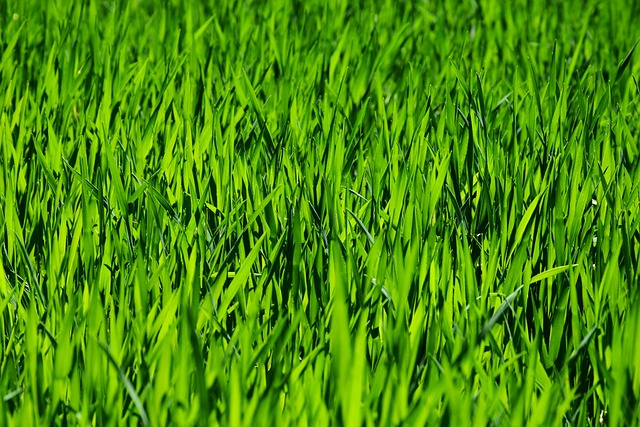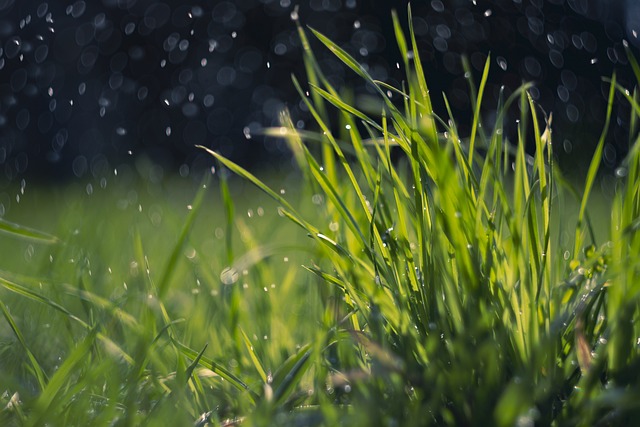Lawns and gardens are under constant threat from various pests that can cause significant damage, leading to unattractive patches and plant stress or death. To effectively manage these threats, lawn care and landscaping professionals must employ a strategic approach involving regular monitoring, timely interventions, and the use of beneficial insects like ladybugs and lacewings to naturally regulate pest populations. A healthy ecosystem can be fostered by adopting sustainable practices such as optimizing grass height, promoting biodiversity with diverse plant species, and ensuring proper nutrient balance. Organic treatments like neem oil or insecticidal soaps and mechanical tools like traps and barriers are safe alternatives for pest control. Understanding pest life cycles is essential for effective treatment timing, and removing harborage areas helps make the environment less hospitable to pests. This comprehensive approach, which includes enhancing soil health and irrigation practices, forms a robust defense against pests, ensuring that lawns and gardens remain lush, healthy, and resilient. Lawn care and landscaping professionals must stay vigilant and adapt their strategies to protect outdoor spaces from the ever-evolving array of pest challenges while maintaining ecological balance.
Protecting your lawn and garden from pests is a year-round endeavor that ensures the vitality of your plants and the beauty of your outdoor spaces. This article delves into the strategies of lawn care and landscaping, focusing on identifying common garden pests, implementing effective control measures, and adopting preventative practices for long-term health. Understanding the impact of these unwanted intruders and learning to manage them is key to maintaining a thriving landscape. With expert insights on various pest control methods and preventative care solutions, your lawn and garden can withstand nature’s challenges and flourish throughout every season.
- Identifying Common Garden Pests and Their Impact on Lawns and Plants
- Effective Pest Control Strategies for Healthy Lawns and Gardens
- Preventative Measures and Long-Term Solutions in Lawn Care and Landscaping
Identifying Common Garden Pests and Their Impact on Lawns and Plants

Lawn care and landscaping professionals often encounter a variety of pests that can wreak havoc on both lawns and garden plants. These pests, ranging from insects to mammals, can lead to significant damage if not properly identified and managed. A common group of pests includes beetles, grubs, and billbugs, which can cause turfgrass to thin and die, creating unsightly patches in the lawn. Other destructive invaders are caterpillars, particularly sod webworms and armyworms, which feed on grass leaves, often mistaking them for their preferred host plants. Additionally, chinch bugs and flea beetles can also cause substantial damage to lawns by feeding on the foliage and stems, leading to a yellowish cast and eventual plant death if left unchecked.
Plants in gardens are equally susceptible to pest infestations, with leafhoppers, aphids, spider mites, and Japanese beetles being among the most problematic. These tiny creatures can transmit diseases as they feed, exacerbating the impact on plants by weakening their immune systems and causing stippling, curling, or yellowing of leaves. The presence of these pests should not be underestimated; they can quickly deplete a plant’s energy resources, making it challenging for plants to grow and flourish. Regular monitoring and timely intervention are key to managing these pests as part of an integrated lawn care and landscaping program, ensuring that your outdoor spaces remain healthy and vibrant.
Effective Pest Control Strategies for Healthy Lawns and Gardens

Implementing effective pest control strategies is crucial for maintaining healthy lawns and gardens. A proactive approach to lawn care and landscaping involves regular inspection and monitoring to detect pests early. Beneficial insects, such as ladybugs and lacewings, can be introduced into the ecosystem to naturally control pest populations. Encouraging biodiversity within your landscape helps establish a balanced environment where predatory insects keep pest numbers in check. Additionally, integrating cultural practices like proper watering, aeration, and fertilization supports plant health, making them more resilient to pest damage. Using organic-based treatments, such as neem oil or insecticidal soaps, can provide an additional layer of protection without harming the environment. Traps and mechanical barriers are also effective tools for managing specific pests, ensuring that your lawn and garden remain vibrant and free from destructive infestations. Regularly reviewing and updating your pest management plan ensures that you address emerging pest threats effectively, promoting a sustainable and healthy outdoor space.
Preventative Measures and Long-Term Solutions in Lawn Care and Landscaping

To effectively safeguard your lawn and garden from pests, a proactive approach is essential. Implementing preventative measures in lawn care and landscaping is key to maintaining a healthy, pest-free environment. Regularly monitoring your yard for signs of insect activity can deter problems before they escalate. Keeping grass trimmed at an optimal height allows sunlight and airflow to reach the soil, which naturally repels many pests. Additionally, maintaining diverse plant species and ensuring they receive appropriate nutrients fosters a resilient landscape less susceptible to pest infestations. Employing beneficial insects, like ladybugs or lacewings, can naturally control aphids and other soft-bodied pests, reducing the need for chemical interventions.
In terms of long-term solutions, establishing a comprehensive lawn care and landscaping plan is crucial. This involves understanding the life cycles of common garden pests and timing your preventative measures accordingly. For instance, applying certain soil treatments or organic-based repellents at specific times can disrupt the pest life cycle and significantly reduce their populations. Moreover, removing debris and weeds that serve as hiding spots for pests is a critical step in creating an inhospitable environment for them. By combining these biological controls with thoughtful landscaping practices, such as promoting soil health and ensuring proper irrigation, you can create a robust defense against pests. This not only protects your plants but also contributes to the overall ecological balance of your outdoor spaces.
Effective lawn care and landscaping practices are pivotal in safeguarding your outdoor spaces from the myriad of pests that can threaten plant health. By identifying common garden pests and understanding their impact, homeowners can implement targeted pest control strategies that maintain a robust defense against these invaders. Preventative measures, when paired with long-term solutions, offer a comprehensive approach to protecting your lawn and gardens. Regular monitoring and timely interventions not only ensure the vitality of your greenery but also contribute to an aesthetically pleasing environment year-round. With diligent attention to lawn care and landscaping, your garden can thrive, resisting the challenges posed by pests and continuing to flourish.
